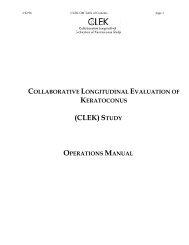The Ocular Hypertension Treatment Study - Vision Research ...
The Ocular Hypertension Treatment Study - Vision Research ...
The Ocular Hypertension Treatment Study - Vision Research ...
Create successful ePaper yourself
Turn your PDF publications into a flip-book with our unique Google optimized e-Paper software.
instructed to fixate on the fixation light. <strong>The</strong> photographerfocuses on the participant’s eye.Fundus cameras used by clinical centers include Zeiss,Kowa, or Topcon cameras to obtain full-frame stereoscopicimages sequentially or Topcon or Nidek cameras to obtainsplit-frame images simultaneously. <strong>The</strong> Donaldson Viewer(George Davco, Holbrook, MA 02343) is used to read twofull-frame 35 mm by 25 mm transparencies and the AsahiStereo Viewer II (Pentax Corp, Englewood, CO 80112) isused to read single split-frame 35 mm by 25 mm transparencies.● CERTIFICATION OF OPTIC DISK READERS AT OPTICDISC READING CENTER: To be certified as an optic diskphotography reader, technicians have to successfully gradea test set of stereophotographs (provided by Joseph Caprioli,MD) side by side with a glaucoma specialist. Trainingof readers was performed largely by DRA. Upon thesuccessful completion of the test set, the trainee completedindependent readings of 50 consecutive sets of slides takenfrom OHTS. To complete certification, the trainee had todemonstrate the ability to agree to within 0.1 DD of theofficial reading on all 50 eyes. Complete details of thetraining of readers at the Optic Disc Reading Center canbe found in the OHTS Manual of Procedures. 12● MEASUREMENT OF HORIZONTAL CUP/DISK RATIO: Stereophotographsare sent to the OHTS Optic Disc ReadingCenter where they are logged, labeled with random identifiers,and graded. Readers are masked as to randomization,clinic, patient ID, visit, prior gradings, fellow eyegrading, and clinical status of the eye. Two primary readersfirst independently grade the photographs for quality (clarityand stereo). If the two primary readers disagree, thestereophotographs are reviewed by a senior reader whosequality grading becomes the official decision. Photographswhose quality is too poor for assessment are not evaluatedfurther and a new set of photographs is requested.<strong>The</strong> primary readers independently conduct side-by-sidecomparisons of technically adequate baseline and follow-upstereophotographs masked as to their order. <strong>The</strong>readers estimate horizontal cup/disk ratio of both baselineand follow-up optic disk stereophotographs thereby regradingthe baseline stereophotographs with each new set ofannual follow-up stereophotographs. <strong>The</strong> primary readersvisually estimate the horizontal cup/disk ratio (3:00 to 9:00meridian) to the nearest 0.1 DD. <strong>The</strong> cup is determined bycontour. Assignment is straightforward when the orientationof both the disk and the cup are cylindrical andparallel to the optical axis. When the cup is conical, theplane midway between the surface of the disk and thedepth of the cup is used as the standard reference plane.When the optic nerve enters the sclera obliquely and theanatomic configuration is tilted with respect to the opticalaxis, an estimate is made of the horizontal cup/disk ratio atthe plane perpendicular to the axis of the insertion of theoptic nerve to the eye. This conceptual midplane perpendicularto the optic nerve axis is chosen to provide thegreatest consistency of the reading for the frequent conditionin which the nasal edge of the cup is steep and thetemporal edge is sloping.If the estimates of horizontal cup/disk ratio of the twoprimary readers are within 0.2 disk diameters (DD) of eachother, the official horizontal cup/disk ratio is the average ofthe two estimates. If the primary readings differ by morethan 0.2 DD, the primary readers attempt to arrive at aconsensus and the official horizontal cup/disk ratio becomesthe average of the two post-consensus estimates. Ifagreement within 0.2 DD is not possible, the senior reader,who is a glaucoma specialist, determines the official horizontalcup/disk ratio. <strong>The</strong> Optic Disc Reading Centerprotocol was prepared by DRA.● ANALYSIS: We assessed reproducibility of horizontalcup/disk ratio over time with the intraclass correlationcoefficient. 13–16 <strong>The</strong> intraclass correlation is an index ofagreement that weights disagreement as the squared distancefrom perfect agreement. For descriptive purposesonly, when the official horizontal cup/disk estimate was theaverage of two readers’ estimates, we rounded the averagedvalue to the nearest 0.1 DD to allow direct comparisons topublished studies. We report the mean and standarddeviation of horizontal cup/disk ratio of baseline photographsgraded at study entry and regraded at annualfollow-up visits at years 1, 2, and 3. We report the meandifference between these readings (follow-up horizontalcup/disk ratio minus entry horizontal cup/disk ratio) andthe 95% confidence intervals of the differences. A paired ttest was used to determine if the difference betweenreadings was greater than zero, that is, greater than or lessthan expected by chance alone.To determine if technician readers differed from glaucomaspecialists, we compared the horizontal cup/disk ratioof the same optic disk stereophotographs as graded bytechnician readers and glaucoma specialists. This analysiswas conducted on a subset of stereophotographs whichwere graded by two glaucoma specialists who served asprimary readers early in the study and which were regradedby two technician readers later in the study. We computedintraclass correlation coefficients to describe agreementbetween glaucoma specialists and technician readers andused a paired t test to determine if the difference wasgreater than expected by chance.To estimate interobserver agreement between the twoprimary readers who graded each set of stereoscopic photographsindependently, we sampled the primary readers’worksheets before consensus and/or adjudication. Left eyesof 100 OHTS participants were randomly selected with acomputer uniform random number generator. <strong>The</strong> differencesbetween the primary readers’ horizontal cup/diskratio measurements before consensus and adjudicationVOL. 133, NO. 1 REPRODUCIBILITY OF CUP/DISK RATIO MEASUREMENTS OVER TIME21
















